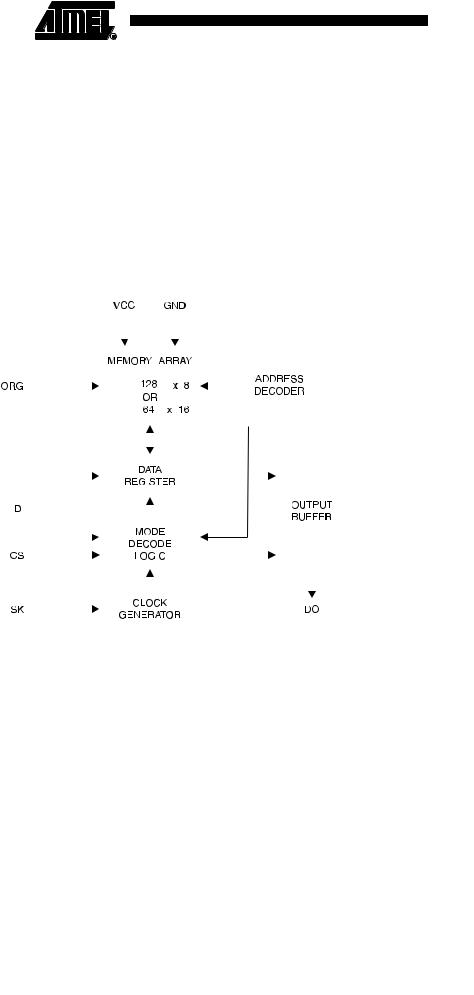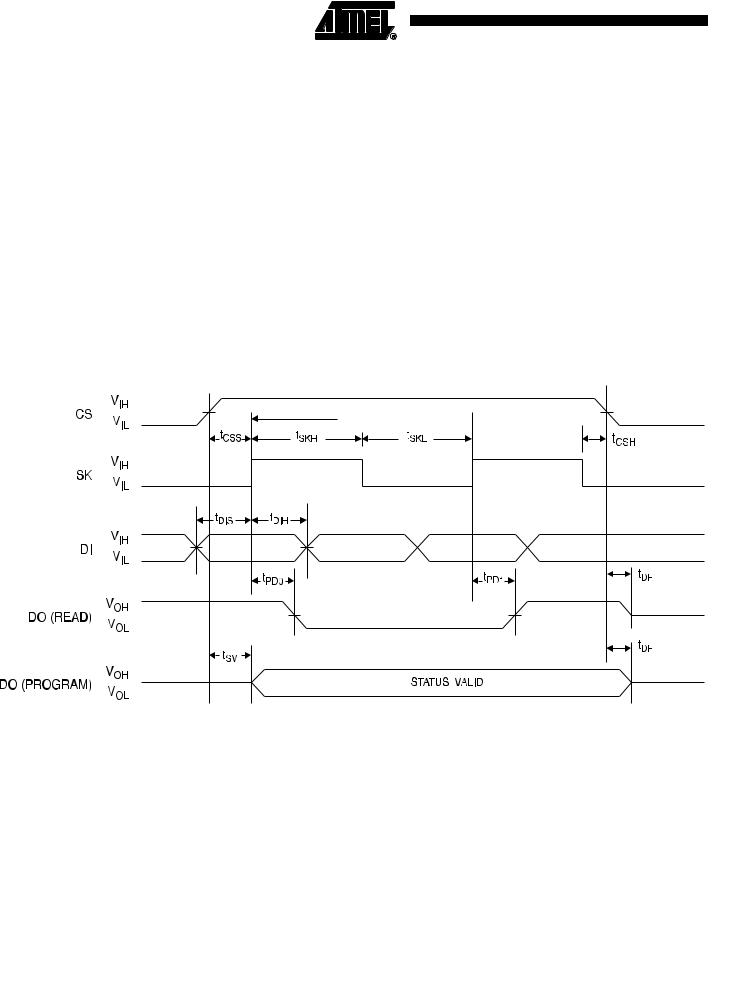Atmel AT93C46-10PU, AT93C46-10SU, AT93C46-10TU, AT93C46W-10SU, AT93C46Y1-10YU Schematics
...
Features
•Low-voltage and Standard-voltage Operation
–2.7 (VCC = 2.7V to 5.5V)
–1.8 (VCC = 1.8V to 5.5V)
•User-selectable Internal Organization
–1K: 128 x 8 or 64 x 16
•Three-wire Serial Interface
•2 MHz Clock Rate (5V)
•Self-timed Write Cycle (10 ms max)
•High Reliability
–Endurance: 1 Million Write Cycles
–Data Retention: 100 Years
•Automotive Grade Devices Available
•8-lead JEDEC PDIP, 8-lead JEDEC SOIC, 8-lead EIAJ SOIC, 8-lead Ultra Thin mini-MAP (MLP 2x3), 8-lead TSSOP and 8-ball dBGA2 Packages
Description
The AT93C46 provides 1024 bits of serial electrically erasable programmable readonly memory (EEPROM), organized as 64 words of 16 bits each (when the ORG pin is connected to VCC), and 128 words of 8 bits each (when the ORG pin is tied to ground). The device is optimized for use in many industrial and commercial applications where low-power and low-voltage operations are essential. The AT93C46 is available in space-saving 8-lead PDIP, 8-lead JEDEC SOIC, 8-lead EIAJ SOIC, 8-lead Ultra Thin mini-MAP (MLP 2x3), 8-lead TSSOP, and 8-lead dBGA2 packages.
The AT93C46 is enabled through the Chip Select pin (CS) and accessed via a three-wire serial interface consisting of Data Input (DI), Data Output (DO), and Shift Clock (SK). Upon receiving a Read instruction at DI, the address is decoded and the data is clocked out serially on the DO pin. The Write cycle is completely self-timed, and no separate Erase cycle is required before Write. The Write cycle is only enabled when the part is in the Erase/Write Enable state. When CS is brought high following the initiation of a Write cycle, the DO pin outputs the Ready/Busy status of the part.
The AT93C46 is available in 2.7V to 5.5V and 1.8V to 5.5V versions.
Table 1. Pin Configurations
Pin Name |
Function |
|
|
CS |
Chip Select |
|
|
SK |
Serial Data Clock |
|
|
DI |
Serial Data Input |
|
|
DO |
Serial Data Output |
|
|
GND |
Ground |
|
|
VCC |
Power Supply |
|
|
ORG |
Internal Organization |
|
|
DC |
Don’t Connect |
|
|
|
8-lead SOIC |
|
8-lead dBGA2 |
||||
|
|
|
|
VCC |
|
|
CS |
|
|
|
|
|
|
||
CS |
1 |
8 |
VCC |
8 |
1 |
||
SK |
2 |
7 |
DC |
DC |
7 |
2 |
SK |
DI |
3 |
6 |
ORG |
ORG |
6 |
3 |
D1 |
DO |
4 |
5 |
GND |
GND |
5 |
4 |
D0 |
|
|
|
|
|
|
|
|
Bottom View
8-lead PDIP
CS |
|
1 |
8 |
|
VCC |
|
|
||||
SK |
|
2 |
7 |
|
DC |
|
|
||||
DI |
|
3 |
6 |
|
ORG |
|
|
||||
DO |
|
4 |
5 |
|
GND |
|
|
||||
|
|
|
|
|
|
8-lead Ultra Thin mini-MAP (MLP 2x3)
8-lead SOIC
Rotated (R)
(1K JEDEC Only)
DC |
|
1 |
8 |
|
ORG |
|
|
||||
VCC |
|
2 |
7 |
|
GND |
|
|
||||
CS |
|
3 |
6 |
|
DO |
|
|
||||
SK |
|
4 |
5 |
|
DI |
|
|
||||
|
|
|
|
|
|
VCC |
|
|
|
CS |
|
8-lead TSSOP |
|
|
|
|
|
|
|
|
|||
|
|
|
|
|
|
|
||
8 |
1 |
CS |
1 |
8 |
VCC |
|||
DC |
|
|
|
SK |
||||
7 |
|
2 |
SK |
2 |
7 |
DC |
||
ORG |
|
|
|
DI |
||||
6 |
|
3 |
DI |
3 |
6 |
ORG |
||
GND |
|
|
|
DO |
||||
5 |
|
4 |
DO |
4 |
5 |
GND |
||
|
|
|
|
|
||||
|
|
|
|
|
|
|
|
|
Bottom View
Three-wire
Serial
EEPROM
1K (128 x 8 or 64 x 16)
AT93C46
Note: Not recommended for new design; please refer to AT93C46D datasheet.
5140B–SEEPR–2/07
1

Absolute Maximum Ratings*
......................................Operating Temperature |
−55°C to +125°C |
|
*NOTICE: Stresses beyond those listed under “Absolute |
||||||||||||||||||
|
|
|
|
|
|
|
|
|
|
|
Maximum Ratings” may cause permanent dam- |
||||||||||
Storage Temperature ......................................... |
−65°C to +150°C |
|
|
|
|
|
|
age to the device. This is a stress rating only, and |
|||||||||||||
|
|
|
|
|
|
|
|
|
|
|
functional operation of the device at these or any |
||||||||||
Voltage on Any Pin |
|
|
|
|
|
|
|
|
|
|
other conditions beyond those indicated in the |
||||||||||
with Respect to Ground ........................................ |
−1.0V to +7.0V |
|
|
|
|
|
|
operational sections of this specification is not |
|||||||||||||
Maximum Operating Voltage |
6.25V |
|
|
|
|
|
|
implied. Exposure to absolute maximum rating |
|||||||||||||
|
|
|
|
|
|
conditions for extended periods may affect |
|||||||||||||||
DC Output Current |
5.0 mA |
|
|
|
|
|
|
device reliability |
|||||||||||||
|
|
|
|
|
|
|
|
|
|
|
|
|
|
|
|
|
|||||
|
|
|
|
|
|
|
|
|
|
|
|
|
|
|
|
|
|
|
|
|
|
|
Figure 1. Block Diagram |
|
|
|
|
|
|
|
|
|
|
|
|
|
|
|
|
||||
|
|
|
|
|
|
|
|
|
|
|
|
|
|
|
|
|
|
|
|
|
|
|
|
|
|
|
|
|
|
|
|
|
|
|
|
|
|
|
|
|
|
|
|
|
|
|
|
|
|
|
|
|
|
|
|
|
|
|
|
|
|
|
|
|
|
|
|
|
|
|
|
|
|
|
|
|
|
|
|
|
|
|
|
|
|
|
|
|
|
|
|
|
|
|
|
|
|
|
|
|
|
|
|
|
|
|
|
|
|
|
|
|
|
|
|
|
|
|
|
|
|
|
|
|
|
|
|
|
|
|
|
|
|
|
|
|
|
|
|
|
|
|
|
|
|
|
|
|
|
|
|
|
|
|
|
|
|
|
|
|
|
|
|
|
|
|
|
|
|
|
|
|
|
|
|
|
|
|
|
|
|
|
|
|
|
|
|
|
|
|
|
|
|
|
|
|
|
|
|
|
|
|
|
|
|
|
|
|
|
|
|
|
|
|
|
|
|
|
|
|
|
|
|
|
|
|
|
|
|
|
|
|
|
|
|
|
|
|
|
|
|
|
|
|
|
|
|
|
|
|
|
|
|
|
|
|
|
|
|
|
|
|
|
|
|
|
|
|
|
|
|
|
|
|
|
|
|
|
|
|
|
|
|
|
|
|
|
|
|
|
|
|
|
|
|
|
|
|
|
|
|
|
|
|
|
|
|
|
|
|
|
|
|
|
|
|
|
|
|
|
|
|
|
|
|
|
|
|
|
|
|
|
|
|
|
|
|
|
|
|
|
|
|
|
|
|
|
|
|
|
|
|
|
|
|
|
|
|
|
|
|
|
|
|
|
|
|
|
|
|
|
|
|
|
|
|
|
|
|
|
|
|
|
|
|
|
|
|
|
|
|
|
|
|
|
|
|
|
|
|
|
|
|
|
|
|
|
|
|
|
|
|
|
|
|
|
|
|
|
|
|
|
|
|
|
|
|
|
|
|
|
|
|
|
|
|
|
|
|
Note: When the ORG pin is connected to VCC, the “x 16” organization is selected. When it is connected to ground, the “x 8” organization is selected. If the ORG pin is left unconnected and the application does not load the input beyond the capability of the internal 1 Meg ohm pullup, then the “x 16” organization is selected. The feature is not available on the 1.8V devices.
For the AT93C46, if “x 16” organization is the mode of choice and Pin 6 (ORG) is left unconnected, Atmel recommends using the AT93C46A device. For more details, see the AT93C46A datasheet.
2 AT93C46 
5140B–SEEPR–2/07

AT93C46
Table 2. Pin Capacitance(1)
Applicable over recommended operating range from TA = 25°C, f = 1.0 MHz, VCC = +5.0V (unless otherwise noted)
Symbol |
|
Test Conditions |
Max |
Units |
Conditions |
COUT |
|
Output Capacitance (DO) |
5 |
pF |
VOUT = 0V |
CIN |
|
Input Capacitance (CS, SK, DI) |
5 |
pF |
VIN = 0V |
Note: 1. |
This parameter is characterized and is not 100% tested. |
|
|
|
|
Table 3. DC Characteristics
Applicable over recommended operating range from: TAI = −40°C to +85°C, VCC = +1.8V to +5.5V, TAE = -40°C to +125°C, VCC = +1.8V to +5.5V (unless otherwise noted)
Symbol |
|
Parameter |
Test Condition |
|
Min |
Typ |
|
Max |
Unit |
||||||
|
|
|
|
|
|
|
|
|
|
|
|
||||
VCC1 |
|
Supply Voltage |
|
|
|
|
1.8 |
|
|
5.5 |
V |
||||
VCC2 |
|
Supply Voltage |
|
|
|
|
2.7 |
|
|
5.5 |
V |
||||
VCC3 |
|
Supply Voltage |
|
|
|
|
4.5 |
|
|
5.5 |
V |
||||
ICC |
|
|
Supply Current |
VCC = 5.0V |
|
READ at 1.0 MHz |
|
|
|
0.5 |
|
2.0 |
mA |
||
|
|
|
|
|
|
|
|
|
|
|
|
||||
|
|
|
WRITE at 1.0 MHz |
|
|
|
0.5 |
|
2.0 |
mA |
|||||
|
|
|
|
|
|
|
|
|
|
|
|||||
|
|
|
|
|
|
|
|
|
|
|
|
|
|
||
ISB1 |
|
|
Standby Current |
VCC = 1.8V |
|
CS = 0V |
|
|
|
0 |
|
0.1 |
µA |
||
ISB2 |
|
|
Standby Current |
VCC = 2.7V |
|
CS = 0V |
|
|
|
6.0 |
|
10.0 |
µA |
||
ISB3 |
|
|
Standby Current |
VCC = 5.0V |
|
CS = 0V |
|
|
|
17 |
|
30 |
µA |
||
IIL |
|
|
Input Leakage |
VIN = 0V to VCC |
|
|
|
0.1 |
|
1.0 |
µA |
||||
IOL |
|
|
Output Leakage |
VIN = 0V to VCC |
|
|
|
0.1 |
|
1.0 |
µA |
||||
VIL1(1) |
|
Input Low Voltage |
|
2.7V ≤ VCC ≤ 5.5V |
|
−0.6 |
|
|
0.8 |
V |
|||||
V |
IH1 |
(1) |
|
Input High Voltage |
|
|
2.0 |
|
V |
CC |
+ 1 |
||||
|
|
|
|
|
|
|
|||||||||
|
|
|
|
|
|
|
|
|
|
|
|
|
|
||
VIL2(1) |
|
Input Low Voltage |
|
1.8V ≤ VCC ≤ 2.7V |
|
−0.6 |
|
VCC x 0.3 |
V |
||||||
V |
IH2 |
(1) |
|
Input High Voltage |
|
V |
CC |
x 0.7 |
|
V |
CC |
+ 1 |
|||
|
|
|
|
|
|
||||||||||
|
|
|
|
|
|
|
|
|
|
|
|
|
|||
VOL1 |
|
Output Low Voltage |
2.7V ≤ VCC |
≤ 5.5V |
IOL = 2.1 mA |
|
|
|
|
|
0.4 |
V |
|||
VOH1 |
|
Output High Voltage |
IOH = −0.4 mA |
|
2.4 |
|
|
|
|
V |
|||||
|
|
|
|
|
|
|
|
||||||||
VOL2 |
|
Output Low Voltage |
1.8V ≤ VCC |
≤ 2.7V |
IOL = 0.15 mA |
|
|
|
|
|
0.2 |
V |
|||
VOH2 |
|
Output High Voltage |
IOH = −100 µA |
VCC – 0.2 |
|
|
|
|
V |
||||||
|
|
|
|
|
|
|
|||||||||
Note: |
1. |
VIL min and VIH max are reference only and are not tested. |
|
|
|
|
|
|
|
|
|||||
3
5140B–SEEPR–2/07

Table 4. AC Characteristics
Applicable over recommended operating range from TAI = −40°C to + 85°C, VCC = As Specified,
CL = 1 TTL Gate and 100 pF (unless otherwise noted)
Symbol |
Parameter |
Test Condition |
|
|
Min |
Typ |
Max |
Units |
|
|
|
|
|
|
|
|
|
|
|
|
SK Clock |
4.5V ≤ VCC |
≤ 5.5V |
|
|
0 |
|
2 |
|
fSK |
Frequency |
2.7V ≤ VCC |
≤ 5.5V |
|
|
0 |
|
1 |
MHz |
|
|
1.8V ≤ VCC |
≤ 5.5V |
|
|
0 |
|
0.25 |
|
tSKH |
|
4.5V ≤ VCC |
≤ 5.5V |
|
|
250 |
|
|
|
SK High Time |
2.7V ≤ VCC |
≤ 5.5V |
|
|
250 |
|
|
ns |
|
|
|
1.8V ≤ VCC |
≤ 5.5V |
|
|
1000 |
|
|
|
tSKL |
|
4.5V ≤ VCC |
≤ 5.5V |
|
|
250 |
|
|
|
SK Low Time |
2.7V ≤ VCC |
≤ 5.5V |
|
|
250 |
|
|
ns |
|
|
|
1.8V ≤ VCC |
≤ 5.5V |
|
|
1000 |
|
|
|
tCS |
Minimum CS |
4.5V ≤ VCC |
≤ 5.5V |
|
|
250 |
|
|
|
Low Time |
2.7V ≤ VCC |
≤ 5.5V |
|
|
250 |
|
|
ns |
|
|
|
1.8V ≤ VCC |
≤ 5.5V |
|
|
1000 |
|
|
|
tCSS |
|
|
|
4.5V ≤ VCC |
≤ 5.5V |
50 |
|
|
|
CS Setup Time |
Relative to SK |
2.7V ≤ VCC |
≤ 5.5V |
50 |
|
|
ns |
||
|
|
|
|
1.8V ≤ VCC |
≤ 5.5V |
200 |
|
|
|
tDIS |
|
|
|
4.5V ≤ VCC |
≤ 5.5V |
100 |
|
|
|
DI Setup Time |
Relative to SK |
2.7V ≤ VCC |
≤ 5.5V |
100 |
|
|
ns |
||
|
|
|
|
1.8V ≤ VCC |
≤ 5.5V |
400 |
|
|
|
tCSH |
CS Hold Time |
Relative to SK |
|
|
0 |
|
|
ns |
|
tDIH |
|
|
|
4.5V ≤ VCC |
≤ 5.5V |
100 |
|
|
|
DI Hold Time |
Relative to SK |
2.7V ≤ VCC |
≤ 5.5V |
100 |
|
|
ns |
||
|
|
|
|
1.8V ≤ VCC |
≤ 5.5V |
400 |
|
|
|
tPD1 |
Output Delay to |
|
|
4.5V ≤ VCC |
≤ 5.5V |
|
|
250 |
|
“1” |
AC Test |
|
2.7V ≤ VCC |
≤ 5.5V |
|
|
250 |
ns |
|
|
|
|
|
1.8V ≤ VCC |
≤ 5.5V |
|
|
1000 |
|
tPD0 |
Output Delay to |
|
|
4.5V ≤ VCC |
≤ 5.5V |
|
|
250 |
|
“0” |
AC Test |
|
2.7V ≤ VCC |
≤ 5.5V |
|
|
250 |
ns |
|
|
|
|
|
1.8V ≤ VCC |
≤ 5.5V |
|
|
1000 |
|
tSV |
CS to Status |
|
|
4.5V ≤ VCC |
≤ 5.5V |
|
|
250 |
|
Valid |
AC Test |
|
2.7V ≤ VCC |
≤ 5.5V |
|
|
250 |
ns |
|
|
|
|
|
1.8V ≤ VCC |
≤ 5.5V |
|
|
1000 |
|
tDF |
CS to DO in High |
AC Test |
|
4.5V ≤ VCC |
≤ 5.5V |
|
|
100 |
ns |
Impedance |
CS = VIL |
|
2.7V ≤ VCC |
≤ 5.5V |
|
|
100 |
||
|
|
1.8V ≤ VCC |
≤ 5.5V |
|
|
400 |
|
||
|
|
|
|
|
|
|
|||
tWP |
Write Cycle Time |
|
|
|
|
|
|
10 |
ms |
|
|
|
|
|
|
|
|
||
|
|
4.5V ≤ VCC |
≤ 5.5V |
0.1 |
3 |
|
ms |
||
|
|
|
|
|
|||||
Endurance(1) |
5.0V, 25°C |
|
|
|
|
1M |
|
|
Write Cycles |
Note: 1. This parameter is characterized and is not 100% tested.
4 AT93C46 
5140B–SEEPR–2/07

 AT93C46
AT93C46
Table 5. Instruction Set for the AT93C46
|
|
Op |
Address |
|
Data |
|
||
|
|
|
|
|
|
|
|
|
Instruction |
SB |
Code |
x 8 |
x 16 |
x 8 |
|
x 16 |
Comments |
|
|
|
|
|
|
|
|
|
READ |
1 |
10 |
A6 – A0 |
A5 – A0 |
|
|
|
Reads data stored in memory, at |
|
|
|
specified address |
|||||
|
|
|
|
|
|
|
|
|
EWEN |
1 |
00 |
11XXXXX |
11XXXX |
|
|
|
Write enable must precede all |
|
|
|
programming modes |
|||||
|
|
|
|
|
|
|
|
|
|
|
|
|
|
|
|
|
|
ERASE |
1 |
11 |
A6 – A0 |
A5 – A0 |
|
|
|
Erases memory location An – A0 |
WRITE |
1 |
01 |
A6 – A0 |
A5 – A0 |
D7 – D0 |
|
D15 – D0 |
Writes memory location An – A0 |
ERAL |
1 |
00 |
10XXXXX |
10XXXX |
|
|
|
Erases all memory locations. Valid |
|
|
|
only at VCC = 4.5V to 5.5V |
|||||
|
|
|
|
|
|
|
|
|
WRAL |
1 |
00 |
01XXXXX |
01XXXX |
D7 – D0 |
|
D15 – D0 |
Writes all memory locations. Valid |
|
only at VCC = 4.5V to 5.5V |
|||||||
|
|
|
|
|
|
|
|
|
EWDS |
1 |
00 |
00XXXXX |
00XXXX |
|
|
|
Disables all programming instructions |
|
|
|
|
|
|
|
|
|
Note: The Xs in the address field represent DON’T CARE values and must be clocked.
Functional
Description
The AT93C46 is accessed via a simple and versatile three-wire serial communication interface. Device operation is controlled by seven instructions issued by the host processor. A valid instruction starts with a rising edge of CS and consists of a start bit (logic “1”) followed by the appropriate op code and the desired memory address location.
READ (READ): The Read (READ) instruction contains the address code for the memory location to be read. After the instruction and address are decoded, data from the selected memory location is available at the serial output pin DO. Output data changes are synchronized with the rising edges of serial clock SK. It should be noted that a dummy bit (logic “0”) precedes the 8- or 16-bit data output string.
ERASE/WRITE ENABLE (EWEN): To assure data integrity, the part automatically goes into the Erase/Write Disable (EWDS) state when power is first applied. An Erase/Write Enable (EWEN) instruction must be executed first before any programming instructions can be carried out. Please note that once in the EWEN state, programming remains enabled until an EWDS instruction is executed or VCC power is removed from the part.
ERASE (ERASE): The Erase (ERASE) instruction programs all bits in the specified memory location to the logical “1” state. The self-timed erase cycle starts once the Erase instruction and address are decoded. The DO pin outputs the Ready/Busy status of the part if CS is brought high after being kept low for a minimum of 250 ns (tCS). A logic “1” at pin DO indicates that the selected memory location has been erased and the part is ready for another instruction.
WRITE (WRITE): The Write (WRITE) instruction contains the 8 or 16 bits of data to be written into the specified memory location. The self-timed programming cycle tWP starts after the last bit of data is received at serial data input pin DI. The DO pin outputs the Read/Busy status of the part if CS is brought high after being kept low for a minimum of 250 ns (tCS). A logic “0” at DO indicates that programming is still in progress. A logic “1” indicates that the memory location at the specified address has been written with the data pattern contained in the instruction and the part is ready for further instructions. A Ready/Busy status cannot be obtained if the CS is brought high after the end of the selftimed programming cycle tWP.
5
5140B–SEEPR–2/07

ERASE ALL (ERAL): The Erase All (ERAL) instruction programs every bit in the memory array to the logic “1” state and is primarily used for testing purposes. The DO pin outputs the Ready/Busy status of the part if CS is brought high after being kept low for a minimum of 250 ns (tCS). The ERAL instruction is valid only at VCC = 5.0V ± 10%.
WRITE ALL (WRAL): The Write All (WRAL) instruction programs all memory locations with the data patterns specified in the instruction. The DO pin outputs the Ready/Busy status of the part if CS is brought high after being kept low for a minimum of 250 ns (tCS). The WRAL instruction is valid only at VCC = 5.0V ± 10%.
ERASE/WRITE DISABLE (EWDS): To protect against accidental data disturb, the Erase/Write Disable (EWDS) instruction disables all programming modes and should be executed after all programming operations. The operation of the Read instruction is independent of both the EWEN and EWDS instructions and can be executed at any time.
Timing Diagrams
Figure 2. Synchronous Data Timing
 s
s 


Note: 1. This is the minimum SK period.
Table 6. Organization Key for Timing Diagrams
|
|
AT93C46 (1K) |
|
|
|
|
|
I/O |
x 8 |
|
x 16 |
|
|
|
|
AN |
A6 |
|
A5 |
DN |
D7 |
|
D15 |
6 AT93C46 
5140B–SEEPR–2/07
